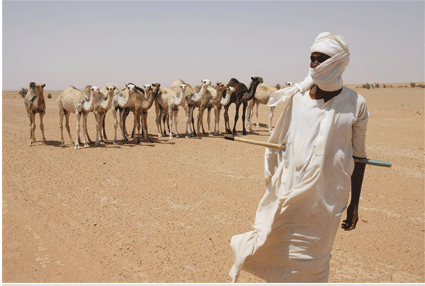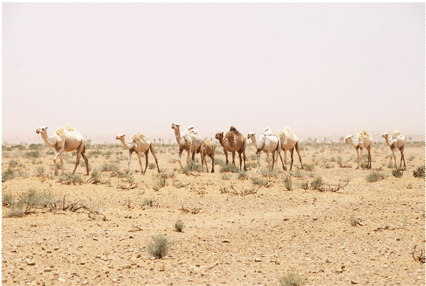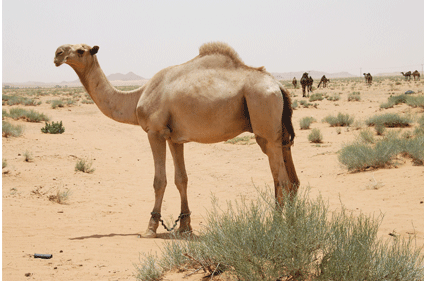 ر
ر
 The milk of the camel is also called “Khalfaat” milk, has many medical benefits that the milk of other animals, such as the cow or goat, does not have. The amount of protein in camel’s milk, is higher than the amount in cow’s milk.
The milk of the camel is also called “Khalfaat” milk, has many medical benefits that the milk of other animals, such as the cow or goat, does not have. The amount of protein in camel’s milk, is higher than the amount in cow’s milk.
They took interest in the camel more than any other animal because of the huge importance it played in their daily lives long before the advent of Islam in the
Ships of the Desert:
The Milk Is the Secret
Camels are a mainstay in the life of the Arabs in olden times because of what God had bestowed upon them, which is
the great ability to withstand the hardships in the desert and the difficulties of traveling through it.
Photos: Hisham Shamma
The number of camels in the world currently stands at 19million head, of which
Worth noting also is that camels are very much sought after by a big section of Arab society for their meat and milk. This is why research is being carried out increasingly on the animal, in an effort to increase its meat and milk production.
Scientifically speaking, the camel belongs to the Camelidae (Camel family), which contains two types of camel, Arabian which has one hump, and the Bukhari which has two. The latter is known as the camel of “Olden Times”.
The camel was mentioned in the Quran in a number of places. For example, Allah states in the Chapter of Al-Ghashiah: “Do they not look at the camel, how it was created?” The verse clearly indicates that this animal has very special features.
The camel also has a very old history. According to Sa’ad Al-Sahli who owns about one hundred camels in the deserts surrounding
This prominence continued after Islam in many sectors of the Arab society, with each local people attaching their local flavor in terms of name and category. For example, in
Paying extra attention to their camels, Arabs have also been very specific with them. For example, a male camel is called a “Jamal” when it reaches four years of age, while the female is called the “Naqah”. On the other hand, a herd of camel containing 3 to 10 camels is called a “Thaud”, while any amount of camel between 10 and 30 would be called a “Sarmah”. A “Hanidah” would be a pack of camel of more than a hundred.
According to Al-Sahli the natural features of the camel is what makes it a favored animal in the environment of the desert. Its top lip for example is cleft, while the bottom one is hanging, which allows it to pick up smaller parts of plant and to chew on thorny branches. Meanwhile the inside of its mouth is nicely lined with buds pointing to the back that protect it from the effect of this roughage. The palate of the mouth is also covered with a soft layer of mucous that keeps its mouth moisturized.
 The eyes are wide, but covered with long lashes, so it is protected well from the sand. The nostrils are lined in heavy hair and can be opened and closed with vigor due to the strong muscles surrounding it. Interestingly enough, the pouches found on the bottom of its belly and thought for so long to be stores of water that allow it to go long periods without water, have been found to contain a liquid that probably does no play this role.
The eyes are wide, but covered with long lashes, so it is protected well from the sand. The nostrils are lined in heavy hair and can be opened and closed with vigor due to the strong muscles surrounding it. Interestingly enough, the pouches found on the bottom of its belly and thought for so long to be stores of water that allow it to go long periods without water, have been found to contain a liquid that probably does no play this role.
Also the camel has a long neck (55 cm), which allows it to reach high when eating. And its humps are basins of fat which it uses when food is limited. Very much worth mentioning also is the fact that the feet of camels have pads underneath them that protect it from the heat of the desert and stop it from “sinking” in its sands.
On a more subtler note, the camel can change its body temperature. In the morning its temperature is between 34 and 35, but increases to between 40 and 41 during midday, when there is a lack of water around. When water is present, the fluctuation in temperature is not more than 2 degrees. The increase in internal temperature with the increase of the temperature outside allows the camel to deal better with the scorching heat of the desert.
The camel again has a urinary system that it is more versatile than that of any other animal, something which allows to accumulate higher concentrations of urine without difficulty. It can, on the other hand, lose up to 30 percent of its weight without affecting the amount of water it contains in its blood. If thirsty it can quickly drink a vast amount water, equal to a third of its weight.
Abdullah, when talking about the disposition of camels, describes them as being very clever, sedate, and not tending to bite or kick, unless aggravated. It can also graze on its own and return to camp without much difficulty, even after long periods. Also it never forgets where water can be found in its grazing area.
The master of the camel (the shepherd for example) can limit the movement of his camel in the graze land by tying a special rope to the front legs of the animal. He can also use a reign or maneuver its tail. But he should be careful not to harm it, or cause it fear or anxiety. It is well-known that sudden changes in treatment or in the atmosphere can cause younger camel to run away.
Camel herds move in small groups ruled by a male respected by the females of the group. If there is competition over leadership then there will be a struggle to gain control until the weaker of the two is defeated. This male then leaves the group.
In general, male camels are unpredictable during mating season. They are quickly enraged, and can express this anger by refusing to do anything except stay in one place. The camel master must be very careful during these times not to aggravate its situation. Having other camels around helps in getting it out of this mood called
“Al-haroon”. It is thought that camel insubordination is due to ill-treatment and to the ignorance of the shepherd.
The training of one-humped camel, to help in transport, or to take part in races, starts when they are between 2 and 3 years old. Most important to be taught the animal is to kneel down when told to do so verbally. Regarding work, experts say that male camel is not good at work before 6 years. An interesting point to add here is the fact that when camels go on long tiring journeys they would continue carrying their load until they drop dead.
According to Abdullah Salem, an owner of camels, all camel owners wait eagerly for the Um Rugaibah festival, the biggest annual gathering for camel traders and owners. Achieving one of the top places is enough to increase the price of any camel to a million Riyals, or even more. On one occasion some owners came from Najran to sell their stock, including breeding males and rare young camels. One breeding male of the “Amlah” type fetched SR 1.6 million, while its offspring fetched half a million each. Bargains concluded during the occasion are done either by direct buying or through exchanging one camel for another, and traders come from the rest of the Gulf to witness the event.
The milk of the camel is another one of its unique features. This milk, also called “Khalfaat” milk, has many medical benefits that milk of other animals, such as the cow or goat, does not have. The amount of protein in camel’s milk, for one, is higher than the amount in cow’s milk. It has also lower levels of fat. This higher level of protein indicates an enhanced level of immunity for the one who drinks this milk.
 When analyzed, the milk of the camel reveals a good level of vitamin C, as compared to cow’s milk. Strangely enough, the camel lives in the desert, where the sources of vitamin C like vegetables and fruit are very limited. So it is as if the camel, in concentrating the amount of vitamin C in its blood, is trying to compensate for this deficiency. Camel’s milk is also a greater source of iron, than any other milk, including mothers’ milk. Then there are the non-saturated fatty acids the milk contains which play a role in protecting the health of one’s heart.
When analyzed, the milk of the camel reveals a good level of vitamin C, as compared to cow’s milk. Strangely enough, the camel lives in the desert, where the sources of vitamin C like vegetables and fruit are very limited. So it is as if the camel, in concentrating the amount of vitamin C in its blood, is trying to compensate for this deficiency. Camel’s milk is also a greater source of iron, than any other milk, including mothers’ milk. Then there are the non-saturated fatty acids the milk contains which play a role in protecting the health of one’s heart.
Anecdotal evidence points to the fact that mixing camel’s milk with honey can help digestion, cure insomnia, and alleviate asthma and cough. If mixed with other known herbs it can also control blood sugar.
The reason perhaps for this plethora of good effects for camel’s milk, is that it grazes on many lands, and hence ingests many (herbal) plants.
Finally, it is reported that in Central Asia and
.